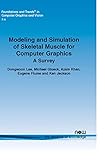Modeling and simulation of skeletal muscle for computer graphics : a survey / Dongwoon Lee [and four others].
Series: Foundations and trends in computer graphics and vision ; no. 7, issue 4.Copyright date: Hanover, MA : Now, [2012], ©2012Description: ix, 51 pages : illustrations ; 24 cmContent type:- text
- unmediated
- volume
- 9781601985521 (paperback)
- 1601985525 (paperback)
| Item type | Current library | Home library | Collection | Call number | Materials specified | Copy number | Status | Date due | Barcode | |
|---|---|---|---|---|---|---|---|---|---|---|
| AM | PERPUSTAKAAN LINGKUNGAN KEDUA | PERPUSTAKAAN LINGKUNGAN KEDUA KOLEKSI AM-P. LINGKUNGAN KEDUA | - | QP321.L434 3 (Browse shelf(Opens below)) | 1 | Available | 00002115848 |
Includes bibliographical references (page 45-51).
'Muscles provide physiological functions to drive body movement and anatomically characterize body shape, making them a crucial component of modeling animated human figures. Substantial effort has been devoted to developing computational models of muscles for the purpose of increasing realism and accuracy in computer graphics and biomechanics. We survey various approaches to model and simulate muscles both morphologically and functionally. Modeling the realistic morphology of muscle requires that muscle deformation be accurately depicted. To this end, several methodologies are presented, including geometrically-based, physically-based, and data-driven approaches. On the other hand, the simulation of physiological muscle functions aims to identify the biomechanical controls responsible for realistic human motion. Estimating these muscle controls has been pursued through static and dynamic simulations. We review and discuss all these approaches, and conclude with suggestions for future research' --Abstract.
There are no comments on this title.

